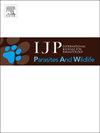Infestation by Sarcoptes scabiei causes distinct differences in sarcoptic mange disease syndromes among sympatric carnivoran species
IF 2
3区 医学
Q3 ECOLOGY
International Journal for Parasitology-Parasites and Wildlife
Pub Date : 2025-04-10
DOI:10.1016/j.ijppaw.2025.101070
引用次数: 0
Abstract
Sarcoptic mange, caused by Sarcoptes scabiei, is a pan-emerging zoonotic disease, affecting new species and expanding into novel geographic locations in recent decades yet the distinct differences in disease syndromes between species remain poorly characterized and understood. This study investigated mange severity, mite burden, and immune response as characterized by dermapathology in sympatric carnivoran species in Pennsylvania, USA, assessing black bears (Ursus americanus), coyotes (Canis latrans), grey foxes (Urocyon cinereoargenteus), and red foxes (Vulpes vulpes). Scabietic and healthy individuals were evaluated using standardized metrics to assess health parameters between infested and healthy individuals and differences in mange disease syndromes between species. Mange severity varied significantly by species. Red foxes and black bears displayed more severe outward signs of mange infestation and higher mite burdens compared to coyotes, which exhibited milder physical and histologic signs of disease. Histologic analyses revealed significant differences in dermatologic lesions; black bears and red foxes more frequently had severe hyperkeratosis, acanthosis, and secondary bacterial and yeast colonization, while coyotes had fewer and milder lesions. In terms of mite detection, tissue digestions were the most sensitive method, followed by cytology and histology. Serological screening detected the highest S. scabiei exposure rates in coyotes (53 %), followed by black bears (37 %), red foxes (17 %), and grey foxes (12 %). Notably, many seropositive coyotes showed no physical signs of mange, suggesting potential resistance or recovery. In contrast, red foxes exhibited severe disease and low seroprevalence, consistent with high mortality and limited recovery. These findings highlight species-specific differences in sarcoptic mange manifestation and host responses. Coyotes may act as reservoirs, contributing to disease persistence in the ecosystem, while red foxes and black bears suffer higher morbidity. This study emphasizes the need for integrated diagnostic and surveillance approaches to improve understanding of S. scabiei epidemiology and inform wildlife management strategies.

疥癣虫的侵染在同域食肉动物物种中引起疥癣病综合征的明显差异
疥癣病是由疥螨引起的一种广泛出现的人畜共患疾病,近几十年来影响新物种并扩展到新的地理位置,但物种之间疾病综合征的明显差异仍然缺乏特征和了解。本研究调查了美国宾夕法尼亚州同域食肉动物的皮肤病理学特征,包括黑熊(Ursus americanus)、土狼(Canis latrans)、灰狐(Urocyon cinereogenteus)和红狐(Vulpes Vulpes)的疥癣严重程度、螨虫负担和免疫反应。使用标准化指标评估受感染个体和健康个体之间的健康参数以及物种之间管理疾病综合征的差异,对疥疮个体和健康个体进行评估。不同物种的管理严重程度差异显著。与土狼相比,红狐和黑熊表现出更严重的管理感染的外部迹象和更高的螨虫负担,而土狼表现出较温和的身体和组织学疾病迹象。组织学分析显示皮肤病变有显著差异;黑熊和红狐更常出现严重的角化过度症、棘层病和继发性细菌和酵母菌定植,而土狼的病变更少、更轻微。组织消化法对螨的检测灵敏度最高,其次为细胞学和组织学。血清学筛查发现,土狼(53%)的疥螨暴露率最高,其次是黑熊(37%)、红狐(17%)和灰狐(12%)。值得注意的是,许多血清阳性的土狼没有出现管理的身体迹象,这表明潜在的抗性或恢复。相比之下,红狐表现出严重的疾病和低血清阳性率,与高死亡率和有限的恢复一致。这些发现强调了类风湿管理表现和宿主反应的物种特异性差异。土狼可能充当宿主,导致疾病在生态系统中持续存在,而红狐和黑熊的发病率更高。本研究强调需要采用综合诊断和监测方法来提高对斯卡比亚氏球菌流行病学的认识,并为野生动物管理策略提供信息。
本文章由计算机程序翻译,如有差异,请以英文原文为准。
求助全文
约1分钟内获得全文
求助全文
来源期刊

International Journal for Parasitology-Parasites and Wildlife
Medicine-Infectious Diseases
CiteScore
3.80
自引率
5.60%
发文量
113
审稿时长
45 days
期刊介绍:
The International Journal for Parasitology: Parasites and Wildlife (IJP-PAW) publishes the results of original research on parasites of all wildlife, invertebrate and vertebrate. This includes free-ranging, wild populations, as well as captive wildlife, semi-domesticated species (e.g. reindeer) and farmed populations of recently domesticated or wild-captured species (e.g. cultured fishes). Articles on all aspects of wildlife parasitology are welcomed including taxonomy, biodiversity and distribution, ecology and epidemiology, population biology and host-parasite relationships. The impact of parasites on the health and conservation of wildlife is seen as an important area covered by the journal especially the potential role of environmental factors, for example climate. Also important to the journal is ''one health'' and the nature of interactions between wildlife, people and domestic animals, including disease emergence and zoonoses.
 求助内容:
求助内容: 应助结果提醒方式:
应助结果提醒方式:


